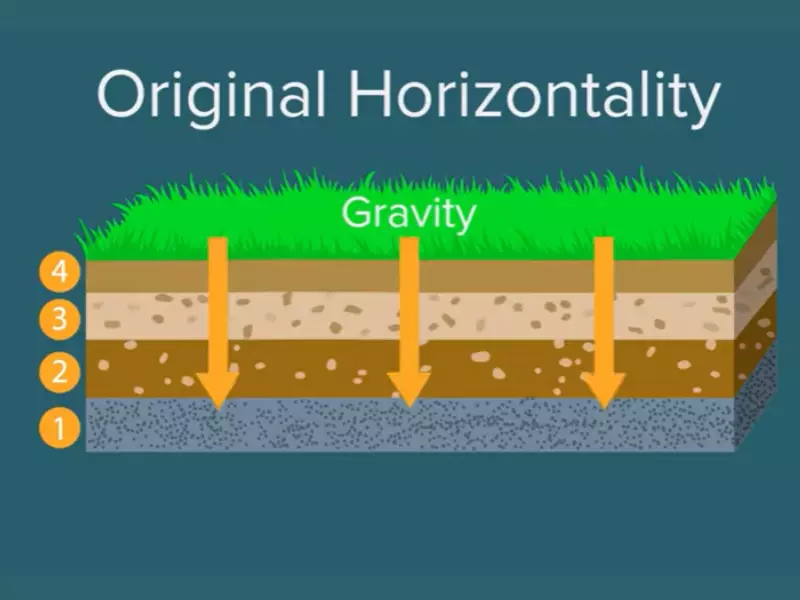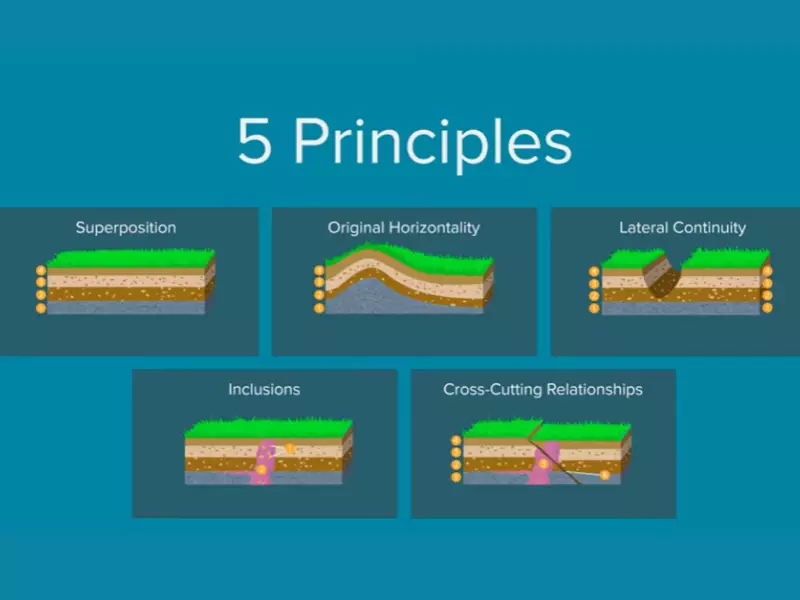Geological dating plays a pivotal role in understanding the Earth’s history, shaping our comprehension of time and evolution. By determining the age of rocks, fossils, and landforms, geologists can unravel the narrative of Earth’s dynamic past, offering insights into ancient environments, climatic changes, and the development of life over millions of years. The concept of age in geology is fundamental, guiding research, exploration, and discovery across the vast expanse of Earth sciences.
The difference between absolute age and relative age lies at the heart of geological dating. Absolute age, or numerical age, is the actual number of years since a rock or object formed. Relative age, in contrast, determines the sequence of events, indicating whether one object is younger or older than another without providing a specific date. This distinction enables scientists to construct a chronological framework of Earth’s geological history, layer by layer, event by event.
While relative dating methods use principles such as superposition and cross-cutting relationships to establish a sequence of events, absolute dating techniques, including radiometric dating, measure radioactive decay to assign specific ages. Both approaches are crucial for piecing together the jigsaw puzzle of our planet’s geological timeline, each providing unique insights that, when combined, offer a more complete picture of the Earth’s ancient past.

Age in Geology
Definition of Geological Age
In geology, age refers to the time since a rock, mineral, or fossil was formed. It provides a window into the Earth’s past, offering clues about the formation of its surface, the evolution of life, and the changes in environmental conditions over millions or even billions of years.
Brief Introduction to Dating Methods
Dating methods in geology are divided into two main categories: absolute and relative dating. Absolute dating gives a numerical age or range in contrast with relative dating which places events in order without any measure of the age between events.
Relative Age
Concept of Relative Dating
Relative dating is the technique of determining the sequence of events from the past. It does not provide specific numbers but tells us which rock or fossil is older or younger than another.
Key Principles
There are several key principles in relative dating:
Superposition
The principle of superposition states that in an undisturbed sequence of rocks, each layer is older than the one above and younger than the one below it. This principle helps scientists to build a relative timeline of geological events.
Original Horizontality
This principle asserts that layers of sediments are originally deposited horizontally under the action of gravity. It is used to identify layers that have been subsequently altered by outside forces.
Cross-Cutting Relationships
According to this principle, a geological feature that cuts across another is the younger of the two features. It’s particularly useful for dating faults and igneous intrusions.
Faunal Succession
Faunal succession is based on the observation that fossil assemblages succeed one another in a definite and recognizable order. This allows for the identification of the relative ages of strata by examining the fossils contained within them.
Examples of Relative Dating
An example of relative dating is the identification of the sequence of geological events in the Grand Canyon. By applying principles like superposition and cross-cutting relationships, geologists can determine the relative ages of the rock layers and the events that have shaped this iconic landscape.
Absolute Age
Definition of Absolute Dating
Absolute dating determines the specific age of a rock, fossil, or archaeological artifact. It measures the decay of radioactive isotopes to calculate how many years have passed since the rock or fossil formed.
Radiometric Dating Techniques
Carbon Dating
Carbon dating, or radiocarbon dating, measures the decay of carbon-14 in organic materials. It’s effective for dating materials up to about 60,000 years old, providing a precise age for archaeological finds.
Uranium-Lead Dating
Uranium-lead dating is one of the oldest and most reliable radiometric dating methods, used to date rocks over a million years old. It measures the decay of uranium isotopes into lead, providing ages for some of the Earth’s oldest rock formations.
Potassium-Argon Dating
Potassium-argon dating is used to date volcanic rocks and is based on the decay of potassium-40 to argon-40. This method is particularly useful for dating rocks older than 100,000 years.
Other Methods of Determining Absolute Age
Tree Rings
Dendrochronology, or tree-ring dating, counts the growth rings in trees to determine the exact year they were formed. It provides precise dates for events like volcanic eruptions or historical buildings.
Ice Cores
Analyzing ice cores from glaciers can reveal the Earth’s past climate conditions, volcanic eruptions, and atmospheric composition, dating back hundreds of thousands of years.
Advantages of Absolute Dating
Absolute dating provides a precise numerical age, offering a more detailed understanding of Earth’s history. It allows for the calibration of the relative dating methods and gives a more complete picture of geological timelines.
Comparing Relative and Absolute Age
Fundamental Differences
The fundamental difference between relative and absolute dating is that relative dating arranges geological events in a sequence without knowing their exact ages, while absolute dating provides a specific numerical age for these events.
Situational Preferences for Each Method
- Relative dating is preferred when looking to construct a sequence of geological events without requiring exact dates.
- Absolute dating is used when a precise age is needed to compare with other data or to calibrate relative dating methods.
Combining Both Methods for Comprehensive Analysis
In practice, geologists often use both relative and absolute dating methods together to create a more complete and accurate picture of Earth’s geological history. This integrated approach maximizes the strengths of each method, providing a detailed chronology of events and formations.

Application in Geological Studies
Stratigraphy and Layer Dating
Stratigraphy, the study of rock layers (strata), is fundamental in understanding Earth’s past. It involves analyzing the sequence and distribution of layers to interpret geological history. Layer dating, combining both relative and absolute dating methods, allows scientists to pinpoint the timing of geological events such as volcanic eruptions, mass extinctions, and major climatic changes. This dual approach provides a more comprehensive timeline of Earth’s geological developments.
Archaeological Dating
In archaeology, dating methods are essential for constructing a chronological record of human activity. Relative dating techniques, like stratigraphy and typology, place artifacts and structures in sequence. Absolute dating, including carbon-14 and thermoluminescence dating, gives a precise age to archaeological finds, offering insights into human evolution, migration patterns, and the development of civilizations.
Earth History and Evolutionary Timeline
The dating of rocks and fossils is crucial for reconstructing the Earth’s history and evolutionary timeline. Through detailed dating of geological formations and fossil records, scientists have been able to map significant events such as the formation of the continents, the rise and fall of species, and the major transitions in Earth’s climate. This has led to the development of the geological time scale, a system of chronological measurement that relates stratigraphy to time and is used by geologists, paleontologists, and other Earth scientists to describe the timing and relationships between events that have occurred throughout Earth’s history.
Challenges and Limitations
Limitations of Relative Dating
While relative dating provides a framework for placing geological events in sequence, it does not offer precise age estimates. This can lead to uncertainties in the chronological order of events, especially when dealing with complex stratigraphic relationships or disturbed rock layers.
Accuracy and Limitations of Radiometric Dating
Radiometric dating, despite its precision, has its own set of challenges. The accuracy of radiometric methods can be affected by factors such as contamination, leakage of daughter isotopes, and assumptions about initial conditions. Furthermore, dating materials that have been heated or altered can lead to erroneous age estimates.
Impact of Environmental Factors
Environmental factors can significantly impact dating accuracy. For example, water can leach away or introduce isotopes, heat can reset radiometric clocks, and physical processes can alter the context of stratigraphic layers. Understanding and mitigating these effects is crucial for accurate dating.
Recent Advances
Improved Radiometric Techniques
Advancements in analytical techniques have greatly improved the precision and accuracy of radiometric dating. Mass spectrometers capable of measuring extremely small amounts of isotopes have enhanced our ability to date geological samples. Developments in isochron dating methods, which do not require knowledge of the initial amount of the daughter isotope, have also helped in overcoming some of the traditional limitations.
New Methods in Absolute Dating
Researchers are continually developing new dating methods to expand the range of materials that can be accurately dated. For instance, luminescence dating techniques, which measure the amount of light released when a mineral is heated or exposed to sunlight, have been refined to provide dates for sediments and pottery. Re-Os (Rhenium-Osmium) dating is another newer method used to date sedimentary rocks and the Earth’s mantle.
Technology’s Role in Enhancing Accuracy
Technology plays a crucial role in enhancing the accuracy and reliability of dating methods. Advanced imaging techniques and computer simulations help in reconstructing fossil distributions and understanding complex geological formations. GIS (Geographic Information Systems) technology is used to analyze spatial relationships in archaeological sites, improving the context for carbon dating. Moreover, AI and machine learning algorithms are being explored for their potential to predict dating accuracy and to identify the most suitable dating methods for specific samples.
Frequently Asked Questions
What is geological dating?
Geological dating encompasses the methods and techniques used to determine the age of Earth materials, such as rocks, fossils, and sediments. By assigning ages to geological samples, scientists can reconstruct the Earth’s history, understanding the timing and order of events that have shaped the planet over billions of years.
Why is knowing the age of rocks important?
Knowing the age of rocks allows scientists to understand Earth’s history, including the formation of its features, the evolution of life, and past climatic conditions. This knowledge is crucial for fields such as paleontology, archaeology, and Earth science, enabling the study of biological evolution, continental drift, and the timing of geological events.
How do scientists determine the relative age of rocks?
Scientists determine the relative age of rocks through principles like superposition, where younger layers are deposited on top of older ones, and cross-cutting relationships, which suggest that geological features that cut through layers are younger than the layers themselves. These principles help construct a relative timeline of geological events.
What are the limitations of radiometric dating?
The limitations of radiometric dating include the potential for contamination, the requirement of certain conditions for accurate dating (such as a closed system), and the assumption that decay rates have remained constant over time. Despite these challenges, radiometric dating remains a critical tool for determining absolute ages.
Conclusion
The exploration of Earth’s history through geological dating has significantly enhanced our understanding of the planet’s past, offering invaluable insights into the forces and events that have shaped its landscape and life. The distinction between absolute and relative age is fundamental, providing two complementary perspectives that together enable a detailed reconstruction of Earth’s geological and biological timeline.
As research advances and technologies evolve, the accuracy and precision of dating methods continue to improve, promising deeper insights and more refined timelines. This continuous quest for knowledge not only satisfies human curiosity but also equips us with the understanding necessary to navigate the challenges of a changing planet, preserving its history and safeguarding its future.
